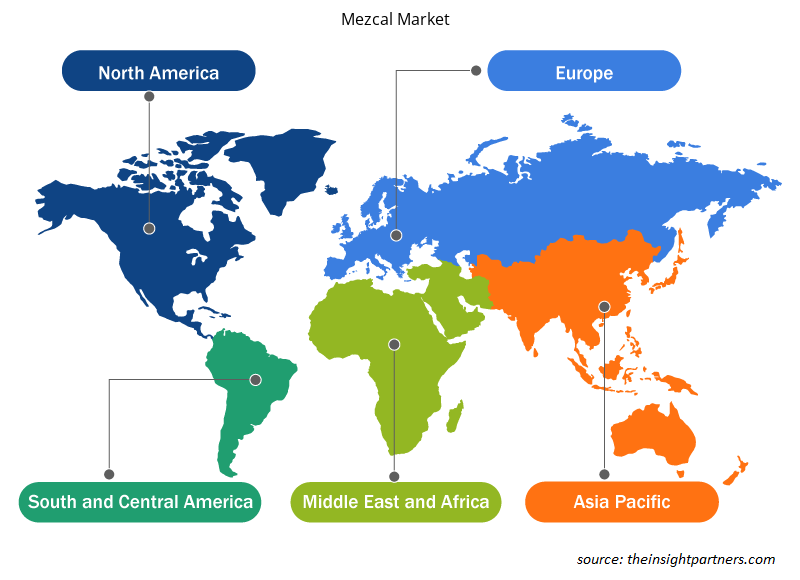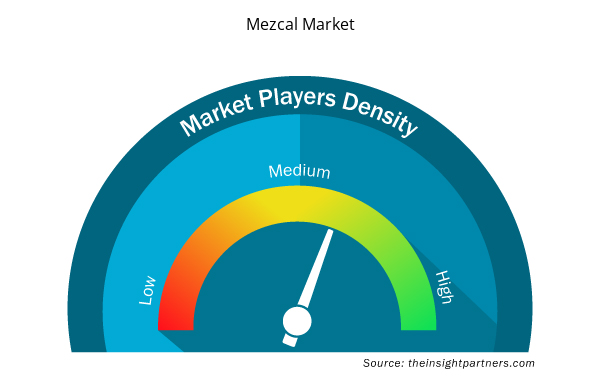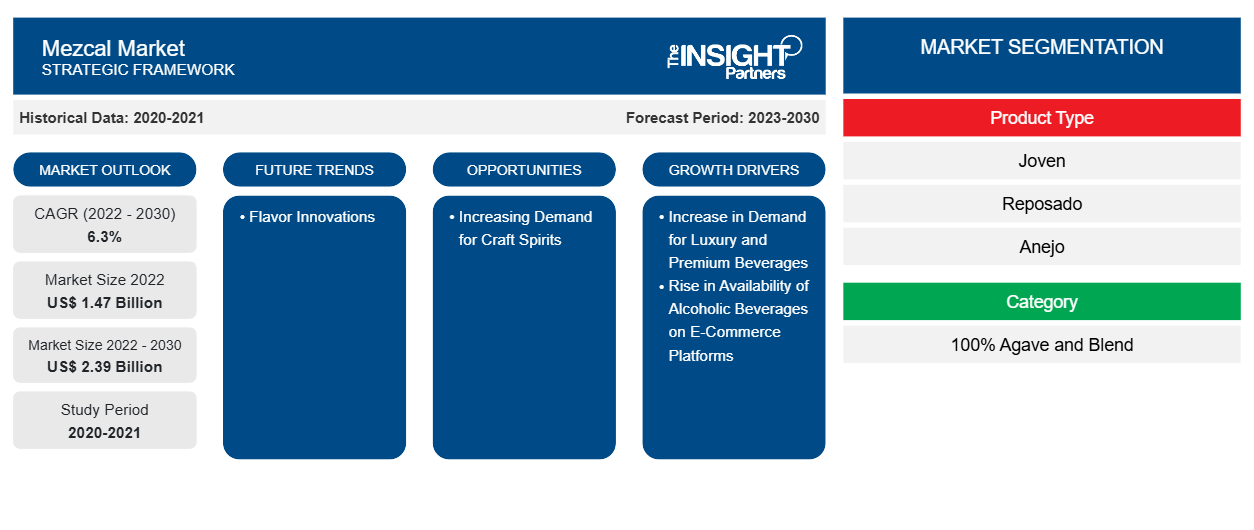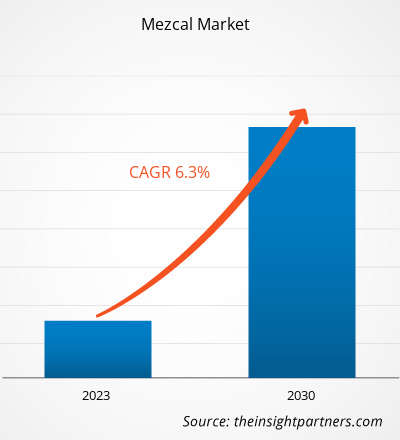[調査レポート] メスカル市場規模は2022年に14億6,917万米ドルと評価され、2030年までに23億9,357万米ドルに達すると予想されており、2022年から2030年にかけて6.3%のCAGRを記録すると予測されています。
市場洞察とアナリストの見解:
メスカルは、主にオアハカ地方のアガベ植物から作られるメキシコ特有のスピリッツです。ブルーアガベのみから作られるメスカルの一種であるテキーラとは異なり、メスカルはさまざまな種類のアガベから作られるため、より幅広い風味と香りが生まれます。メスカルの需要が急増しているのは、職人技による製造方法、独特のスモーキーな風味、クラフトスピリッツへの評価の高まりによるものです。消費者は飲酒体験に本物と多様性を求める傾向が強まっており、冒険好きなスピリッツ愛好家やミクソロジストの間でメスカルの人気が高まっています。その文化的遺産と伝統的な製造技術も魅力を高めており、アガベベースのスピリッツの豊かな世界を探求したい人にとって人気の選択肢となっています。
成長の原動力と課題:
高級飲料やプレミアム飲料の需要の高まりが、メスカル市場の原動力となっています。このトレンドの重要なきっかけの 1 つは、消費者の可処分所得の増加です。人々の収入が増えるにつれて、メスカルなどの高級スピリッツを楽しむために予算の一部を割り当てる傾向が強まっています。これにより、消費者が独特で高級な飲酒体験を求める中、プレミアム メスカル ブランドが繁栄する機会が生まれました。さらに、ミレニアル世代の影響も軽視できません。この人口統計コホートは、品質、信頼性、ユニークなフレーバー プロファイルへの欲求に駆られ、高級飲料に特にお金を使う傾向を示しています。メスカルはこれらの好みに完全に一致しており、ミレニアル世代の共感を呼ぶ手作りの職人技の製品を提供し、需要の急増に大きく貢献しています。
要件に合わせてレポートをカスタマイズする
このレポートの一部、国レベルの分析、Excelデータパックなど、あらゆるレポートを無料でカスタマイズできます。また、スタートアップや大学向けのお得なオファーや割引もご利用いただけます。
- このレポートの主要な市場動向を入手してください。この無料サンプルには、市場動向から見積もりや予測に至るまでのデータ分析が含まれます。
さらに、消費者の嗜好の変化はメスカル市場の発展に重要な役割を果たしています。現代の消費者は、普通を超えたユニークで洗練されたスピリッツをますます求めています。複雑な製造プロセス、スモーキーな香り、独特の風味を持つメスカルは、この変化にうまく適合しています。メスカルは洗練された味の象徴となり、高級飲料としての評判を獲得し、より上質な飲酒体験を求める目の肥えた消費者を魅了しています。
カクテル文化の急成長は、メスカルが高級飲料市場で台頭する一因となっています。バーテンダーやミクソロジストは、ユニークで革新的なカクテルを作るための万能で高級な材料としてメスカルを取り入れています。そのスモーキーで複雑な風味は飲み物に深みと個性を与え、高級バーやレストランで人気の選択肢となっています。これによりメスカルの認知度が高まり、家庭でこうした高級カクテル体験を再現したいという消費者の関心が高まり、需要がさらに高まっています。
最後に、メスカルが高級品であるという認識は、効果的なマーケティング戦略と特徴的なパッケージによって強化されました。高級メスカル ブランドは、製品の職人技を強調し、その独占性を強調する洗練されたブランディングに投資してきました。このマーケティング手法は、ステータス シンボルやユニークなギフト オプションを求める消費者を引き付け、高級スピリッツ市場におけるメスカルの需要を高めています。
しかし、メキシコではメスカルの生産、ラベル付け、認証を規制する厳格な規制があります。メスカルの原産地と伝統的な生産方法を保護するメスカルの原産地呼称は、生産者にとって負担となる可能性のある一連の規則を課しています。たとえば、「メスカル」とラベル付けされるには、蒸留酒はメキシコの一部の地域に主に生息する特定の種類のアガベ植物から作られ、伝統的な方法で生産されている必要があります。伝統的な方法には、土の穴または粘土のオーブンでの調理、手作業による製粉、石または有機の穴での発酵、銅または粘土の鍋での直火による蒸留が含まれます。これらの要件を満たすにはコストがかかったり、時間がかかり、小規模な生産者が市場に参入して効果的に競争する能力が制限されます。
もう一つの規制上の課題は、認証とラベル付けに関するものです。生産者は厳格な品質基準を遵守し、公式の「メスカル」ラベルを貼るために認証プロセスを受ける必要があります。これは、官僚的な手続きをこなすためのリソースや必要な設備や施設に投資する余裕のない、小規模な地元生産者にとっては障壁となる可能性があります。さらに、ラベル付けと広告に関する厳格な規則には、使用するアガベの種類、生産地域、蒸留プロセスの指定が含まれます。これらの規則から逸脱すると法的問題につながる可能性があるため、生産者は細心の注意を払って遵守する必要があります。これらの規制上の制約は、特に小規模なメスカル生産者にとって、市場参入を制限し、革新を妨げ、コンプライアンス コストを生み出す可能性があります。
レポートのセグメンテーションと範囲:
世界のメスカル市場は、 製品タイプ、カテゴリ、流通チャネル、および地理に基づいてセグメント化されています。製品タイプに基づいて、市場はホベン、レポサド、アネホ、その他に分類されます。カテゴリ別に、市場は100%アガベとブレンドに分かれています。流通チャネル別に、市場はスーパーマーケットとハイパーマーケット、専門店、オンライン小売、その他に分類されています。地理別に、世界のメスカル市場は、北米、ヨーロッパ、アジア太平洋、中東およびアフリカ、南米および中米に大まかに分割されています。
セグメント分析:
製品タイプに基づいて、市場はホベン、レポサド、アネホ、その他に分類されます。レポサドセグメントは、2022年から2030年の間に最高のCAGRを記録すると予想されています。スペイン語で「休ませた」と訳されるレポサドは、ホベンの若々しい大胆さとアネホメスカルの熟成された複雑さの中間を表しています。オーク樽で2か月から1年という比較的短い熟成プロセスを経ます。この熟成により、スピリッツにまろやかな特徴が与えられ、アガベの鋭いエッジの一部が滑らかになります。コアとなるアガベの風味を維持しながら、レポサドメスカルはバニラ、キャラメル、木の香りなどの追加のニュアンスを生み出します。その需要が急増しているのは、ホベンの熟成されていない活気とアネホの洗練された複雑さのバランスをとることができるためであり、より滑らかで親しみやすいメスカル体験を求める人々に好まれています。
地域分析:
メスカル市場は、北米、ヨーロッパ、アジア太平洋、中南米、中東アフリカの5つの主要地域に分かれています。北米は世界のメスカル市場を支配し、2022年の地域市場は6億1,220万米ドルを占めました。ヨーロッパは2番目に大きな貢献者であり、世界市場の29%以上のシェアを占めています。アジア太平洋地域は、2022年から2030年の間に7%を超えるかなりのCAGRを記録すると予想されています。メスカルは、中国、インド、日本、オーストラリアなどのアジア諸国の消費者の間で人気が高まっています。メスカルへの消費者のシフトは、主に健康への懸念の高まりに起因しています。贅沢なアルコール飲料への好みの高まりにより、メスカルの需要が増加しており、APACでの市場成長を促進すると予想されています。
メスカル市場の地域別洞察
予測期間を通じてメスカル市場に影響を与える地域的な傾向と要因は、Insight Partners のアナリストによって徹底的に説明されています。このセクションでは、北米、ヨーロッパ、アジア太平洋、中東、アフリカ、南米、中米にわたるメスカル市場のセグメントと地理についても説明します。

- メスカル市場の地域別データを入手
メスカル市場レポートの範囲
| レポート属性 | 詳細 |
|---|---|
| 2022年の市場規模 | 14億7千万米ドル |
| 2030年までの市場規模 | 23億9千万米ドル |
| 世界のCAGR(2022年 - 2030年) | 6.3% |
| 履歴データ | 2020-2021 |
| 予測期間 | 2023-2030 |
| 対象セグメント | 製品タイプ別
|
| 対象地域と国 | 北米
|
| 市場リーダーと主要企業プロフィール |
|
メスカル市場のプレーヤー密度:ビジネスダイナミクスへの影響を理解する
メスカル市場は、消費者の嗜好の変化、技術の進歩、製品の利点に対する認識の高まりなどの要因により、エンドユーザーの需要が高まり、急速に成長しています。需要が高まるにつれて、企業は提供品を拡大し、消費者のニーズを満たすために革新し、新たなトレンドを活用し、市場の成長をさらに促進しています。
市場プレーヤー密度とは、特定の市場または業界内で活動している企業または会社の分布を指します。これは、特定の市場スペースに、その市場規模または総市場価値に対してどれだけの競合相手 (市場プレーヤー) が存在するかを示します。
メスカル市場で活動している主要企業は次のとおりです。
- カーサ アガベ株式会社
- キキリキメスカル株式会社
- ダビデ・カンパリ・ミラノNV
- ヘンテ・デ・メスカルSAデCV
- バカルディ・マティーニBV
免責事項:上記の企業は、特定の順序でランク付けされていません。

- メスカル市場の主要なプレーヤーの概要を入手
COVID-19パンデミックの影響:
COVID-19パンデミックは当初、製造ユニットの閉鎖、労働力不足、サプライチェーンの混乱、金融不安により、世界のメスカル市場の足を引っ張った。COVID-19の発生による経済減速によるさまざまな産業の混乱により、メスカルの供給が抑制された。多くの酒屋が閉店した。しかし、以前に課されていた制限がさまざまな国で緩和されたため、ビジネスは回復し始めた。さらに、さまざまな国の政府によるCOVID-19ワクチンの導入により状況が緩和され、世界中でビジネス活動が増加した。メスカル市場を含むいくつかの市場は、ロックダウンと移動制限の緩和後に成長を報告した。
競争環境と主要企業:
Casa Agave Ltd、Quiquiriqui Mezcal Ltd、Davide Campari Milano NV、Gente de Mezcal SA de CV、Bacardi-Martini BV、Diageo Plc、Pernod Ricard SA、Meanwhile Drinks Ltd、Proximo Spirits Inc、Madre Mezcal Inc は、世界のメスカル市場で活動している著名な企業です。
- 過去2年間の分析、基準年、CAGRによる予測(7年間)
- PEST分析とSWOT分析
- 市場規模価値/数量 - 世界、地域、国
- 業界と競争環境
- Excel データセット



Report Coverage
Revenue forecast, Company Analysis, Industry landscape, Growth factors, and Trends

Segment Covered
This text is related
to segments covered.

Regional Scope
North America, Europe, Asia Pacific, Middle East & Africa, South & Central America

Country Scope
This text is related
to country scope.
よくある質問
The major players operating in the global mezcal market are Casa Agave Ltd, Quiquiriqui Mezcal Ltd, Davide Campari Milano NV, Gente de Mezcal SA de CV, Bacardi-Martini BV, Diageo Plc, Pernod Ricard SA, Meanwhile Drinks Ltd, Proximo Spirits Inc, and Madre Mezcal Inc among others.
In 2022, North America region accounted for the largest share of the global mezcal market. The North American region comprises developed and developing economies such as the U.S. and Canada, and Mexico. Several mezcal breweries have a strong foothold in the North American region. Key market players in the North American mezcal market include E.L. Silencio Holdings, Inc., Mezcal Vago, Ilegal Mezcal, Rey Campero, and many others. These breweries are constantly working towards innovation and developing different varieties of mezcal with improved tastes and qualities to attract new consumers and widen the consumer base in the region. The export of mezcal to several countries across North America will contribute to the rise in demand for mezcal in the region. Innovative programs aimed at marketing the product across North America will increase demand for mezcal in North America.
The rising demand for luxury and premium beverages has emerged as a driving force for the Mezcal market. One significant catalyst for this trend is the increase in the disposable income of consumers. As people's earnings have grown, they are more inclined to allocate a portion of their budget to indulging in high-end spirits such as Mezcal. This has opened up opportunities for premium Mezcal brands to thrive as consumers seek distinctive, elevated drinking experiences. Additionally, the influence of millennials cannot be understated. This demographic cohort has shown a particular penchant for spending on high-end beverages, driven by a desire for quality, authenticity, and unique flavor profiles. Mezcal aligns perfectly with these preferences, offering a handcrafted and artisanal product that resonates with the millennial demographic, contributing significantly to the surge in demand. Moreover, the evolution of consumer preferences plays a pivotal role in driving the Mezcal market. Modern consumers increasingly seek unique and sophisticated spirits that go beyond the ordinary. With its intricate production process, smoky notes, and distinct flavors, Mezcal aligns well with this shift. It has become a symbol of refined taste and has gained a reputation as a premium beverage choice, attracting discerning consumers looking for a more elevated drinking experience.
Based on product type, the market is categorized into joven, reposado, anejo, and others. The reposado segment is expected to register the highest CAGR during 2022–2030. Reposado, which translates to "rested" in Spanish, represents a middle ground between the youthful boldness of joven and the aged complexity of anejo mezcal. It undergoes a relatively short aging process of two months to one year in oak barrels. This aging imparts a mellower character to the spirit, smoothing out some of the agave's sharper edges. While retaining the core agave flavors, reposado mezcal develops additional nuances, such as hints of vanilla, caramel, and wood. Its surging demand is due to its ability to balance the unaged vibrancy of joven and the refined complexity of anejo, making it a preferred choice for those seeking a smoother and more approachable mezcal experience.
Based on category, the mezcal market is segmented into 100% agave and blend. 100% agave category represents mezcal made exclusively from agave plants, with no other sugar sources added during fermentation or distillation. It embodies the traditional and authentic spirit of mezcal production, highlighting various agave species' unique flavors and characteristics. The demand for 100% agave mezcal has been steadily increasing due to consumer's growing appreciation for pure and unadulterated spirits. Discerning drinkers seek the true essence of mezcal, valuing the rich diversity of agave flavors and the dedication of mezcaleros in preserving centuries-old production methods. This category's surge in popularity can be attributed to a desire for transparency and authenticity in the mezcal market as consumers become more educated about the significance of 100% agave labeling.
Mezcal producers are increasingly experimenting with different agave varietals, aging methods, and flavor infusions, which cater to changing consumer preferences and provide unique selling points for their brands. One example of flavor innovation is the use of different agave varieties. While espadin agave is the most commonly used for Mezcal production, some producers explore lesser-known agave types such as tobala, tepextate, and arroqueno. Each agave variety brings its distinct flavor profile to the Mezcal, from earthy and vegetal to fruity and floral notes. This diversity allows consumers to explore various flavors within the Mezcal category, catering to various palate preferences.
Another avenue of innovation involves the aging process. Mezcal aging can occur in various containers, such as oak barrels, glass, or clay pots. Producers experiment with different aging periods and container types to impart unique flavors and aromas. For instance, extended aging in oak barrels can introduce hints of vanilla and caramel, enhancing the complexity of the final product. This approach mirrors the techniques often seen in the whiskey and wine industries, offering a bridge for consumers transitioning from those spirits to Mezcal.
Trends and growth analysis reports related to Food and Beverages : READ MORE..
The List of Companies - Mezcal Market
- Casa Agave Ltd
- Quiquiriqui Mezcal Ltd
- Davide Campari Milano NV
- Gente de Mezcal SA de CV
- Bacardi-Martini BV
- Diageo Plc
- Pernod Ricard SA
- Meanwhile Drinks Ltd
- Proximo Spirits Inc
- Madre Mezcal Inc
The Insight Partners performs research in 4 major stages: Data Collection & Secondary Research, Primary Research, Data Analysis and Data Triangulation & Final Review.
- Data Collection and Secondary Research:
As a market research and consulting firm operating from a decade, we have published and advised several client across the globe. First step for any study will start with an assessment of currently available data and insights from existing reports. Further, historical and current market information is collected from Investor Presentations, Annual Reports, SEC Filings, etc., and other information related to company’s performance and market positioning are gathered from Paid Databases (Factiva, Hoovers, and Reuters) and various other publications available in public domain.
Several associations trade associates, technical forums, institutes, societies and organization are accessed to gain technical as well as market related insights through their publications such as research papers, blogs and press releases related to the studies are referred to get cues about the market. Further, white papers, journals, magazines, and other news articles published in last 3 years are scrutinized and analyzed to understand the current market trends.
- Primary Research:
The primarily interview analysis comprise of data obtained from industry participants interview and answers to survey questions gathered by in-house primary team.
For primary research, interviews are conducted with industry experts/CEOs/Marketing Managers/VPs/Subject Matter Experts from both demand and supply side to get a 360-degree view of the market. The primary team conducts several interviews based on the complexity of the markets to understand the various market trends and dynamics which makes research more credible and precise.
A typical research interview fulfils the following functions:
- Provides first-hand information on the market size, market trends, growth trends, competitive landscape, and outlook
- Validates and strengthens in-house secondary research findings
- Develops the analysis team’s expertise and market understanding
Primary research involves email interactions and telephone interviews for each market, category, segment, and sub-segment across geographies. The participants who typically take part in such a process include, but are not limited to:
- Industry participants: VPs, business development managers, market intelligence managers and national sales managers
- Outside experts: Valuation experts, research analysts and key opinion leaders specializing in the electronics and semiconductor industry.
Below is the breakup of our primary respondents by company, designation, and region:

Once we receive the confirmation from primary research sources or primary respondents, we finalize the base year market estimation and forecast the data as per the macroeconomic and microeconomic factors assessed during data collection.
- Data Analysis:
Once data is validated through both secondary as well as primary respondents, we finalize the market estimations by hypothesis formulation and factor analysis at regional and country level.
- Macro-Economic Factor Analysis:
We analyse macroeconomic indicators such the gross domestic product (GDP), increase in the demand for goods and services across industries, technological advancement, regional economic growth, governmental policies, the influence of COVID-19, PEST analysis, and other aspects. This analysis aids in setting benchmarks for various nations/regions and approximating market splits. Additionally, the general trend of the aforementioned components aid in determining the market's development possibilities.
- Country Level Data:
Various factors that are especially aligned to the country are taken into account to determine the market size for a certain area and country, including the presence of vendors, such as headquarters and offices, the country's GDP, demand patterns, and industry growth. To comprehend the market dynamics for the nation, a number of growth variables, inhibitors, application areas, and current market trends are researched. The aforementioned elements aid in determining the country's overall market's growth potential.
- Company Profile:
The “Table of Contents” is formulated by listing and analyzing more than 25 - 30 companies operating in the market ecosystem across geographies. However, we profile only 10 companies as a standard practice in our syndicate reports. These 10 companies comprise leading, emerging, and regional players. Nonetheless, our analysis is not restricted to the 10 listed companies, we also analyze other companies present in the market to develop a holistic view and understand the prevailing trends. The “Company Profiles” section in the report covers key facts, business description, products & services, financial information, SWOT analysis, and key developments. The financial information presented is extracted from the annual reports and official documents of the publicly listed companies. Upon collecting the information for the sections of respective companies, we verify them via various primary sources and then compile the data in respective company profiles. The company level information helps us in deriving the base number as well as in forecasting the market size.
- Developing Base Number:
Aggregation of sales statistics (2020-2022) and macro-economic factor, and other secondary and primary research insights are utilized to arrive at base number and related market shares for 2022. The data gaps are identified in this step and relevant market data is analyzed, collected from paid primary interviews or databases. On finalizing the base year market size, forecasts are developed on the basis of macro-economic, industry and market growth factors and company level analysis.
- Data Triangulation and Final Review:
The market findings and base year market size calculations are validated from supply as well as demand side. Demand side validations are based on macro-economic factor analysis and benchmarks for respective regions and countries. In case of supply side validations, revenues of major companies are estimated (in case not available) based on industry benchmark, approximate number of employees, product portfolio, and primary interviews revenues are gathered. Further revenue from target product/service segment is assessed to avoid overshooting of market statistics. In case of heavy deviations between supply and demand side values, all thes steps are repeated to achieve synchronization.
We follow an iterative model, wherein we share our research findings with Subject Matter Experts (SME’s) and Key Opinion Leaders (KOLs) until consensus view of the market is not formulated – this model negates any drastic deviation in the opinions of experts. Only validated and universally acceptable research findings are quoted in our reports.
We have important check points that we use to validate our research findings – which we call – data triangulation, where we validate the information, we generate from secondary sources with primary interviews and then we re-validate with our internal data bases and Subject matter experts. This comprehensive model enables us to deliver high quality, reliable data in shortest possible time.


 このレポートの無料サンプルを入手する
このレポートの無料サンプルを入手する